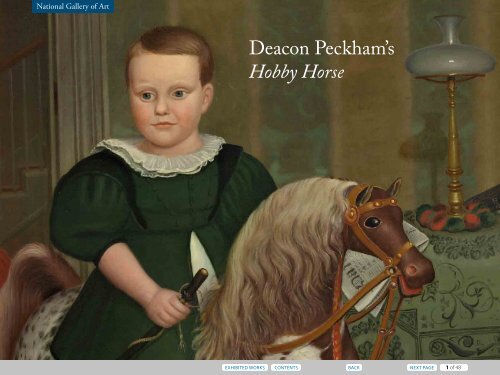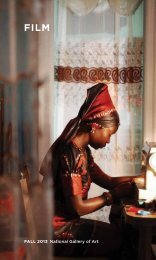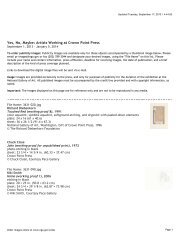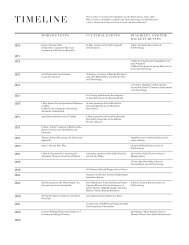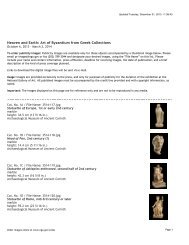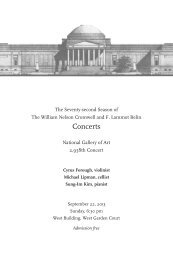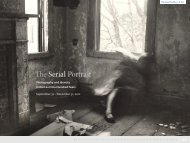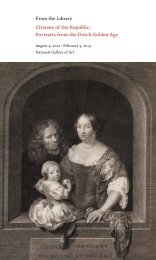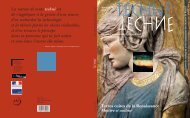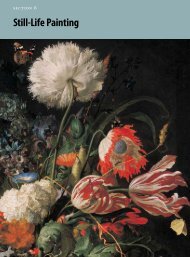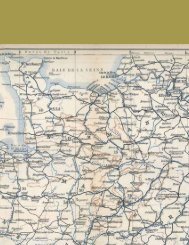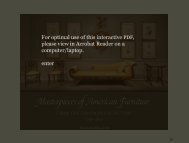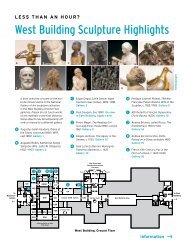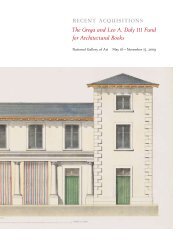NGA | Deacon Peckham's Hobby Horse - National Gallery of Art
NGA | Deacon Peckham's Hobby Horse - National Gallery of Art
NGA | Deacon Peckham's Hobby Horse - National Gallery of Art
You also want an ePaper? Increase the reach of your titles
YUMPU automatically turns print PDFs into web optimized ePapers that Google loves.
<strong>National</strong> <strong>Gallery</strong> <strong>of</strong> <strong>Art</strong><br />
<strong>Deacon</strong> Peckham’s<br />
<strong>Hobby</strong> <strong>Horse</strong><br />
1 <strong>of</strong> 48
<strong>Deacon</strong> Peckham’s<br />
<strong>Hobby</strong> <strong>Horse</strong><br />
Deborah Chotner<br />
<strong>National</strong> <strong>Gallery</strong> <strong>of</strong> <strong>Art</strong>, Washington<br />
May 27 – October 8, 2012<br />
2 <strong>of</strong> 48
Contents<br />
4 Robert Peckham and His Portraits <strong>of</strong> Children<br />
15 Exhibited Works<br />
34 Chronology<br />
44 Glossary<br />
46 Selected Bibliography<br />
3 <strong>of</strong> 48
Robert Peckham and His Portraits<br />
<strong>of</strong> Children<br />
In the 1830s and 1840s Robert Peckham (1785 – 1877) created a<br />
group <strong>of</strong> fascinating children’s portraits. This exhibition represents<br />
the first time that a selection <strong>of</strong> them has been brought together<br />
before a national audience.1 It includes nine portraits <strong>of</strong> children<br />
from Massachusetts along with a rare nineteenth-century rock-<br />
ing horse similar to the one depicted in Peckham’s most engaging<br />
painting, The <strong>Hobby</strong> <strong>Horse</strong> (no. 9).<br />
Born in Petersham, Massachusetts, on September 10, 1785,<br />
Peckham appears to have spent most <strong>of</strong> his long life in the cen-<br />
tral part <strong>of</strong> the state (see Chronology). In 1813 he married Ruth<br />
Wolcott Sawyer, who eventually bore him nine children; they<br />
lived first in Northampton, where Peckham advertised his ser-<br />
vices as an ornamental and sign painter, and then in Bolton.2 He<br />
clearly saw himself as a portrait painter early on, for he placed this<br />
descriptor first in an 1814 advertisement listing his services. Yet<br />
his only training appears to have been a few months in 1809 that<br />
he spent studying with the somewhat more established Ethan<br />
4 <strong>of</strong> 48
fig 1 robert Peckham,<br />
Westminster Village, 1831,<br />
oil on board, Forbush<br />
Memorial library, Westminster,<br />
Massachusetts<br />
Allen Greenwood (1779 – 1856) in the town <strong>of</strong> Westminster.3 There<br />
Peckham lived for most <strong>of</strong> his life, beginning with his purchase <strong>of</strong><br />
land in 1820 (fig. 1).<br />
Peckham was appointed deacon <strong>of</strong> Westminster’s First Con-<br />
gregational Church in 1828, a post he would hold for fourteen<br />
years. He retained the title <strong>of</strong> deacon throughout his life, even<br />
during years <strong>of</strong> controversy and estrangement from his church<br />
stemming from disagreement among the members concerning<br />
the extent <strong>of</strong> their participation in abolitionist activities. Peck-<br />
ham was deeply committed to the cause. According to his young-<br />
est daughter, the deacon’s home served as part <strong>of</strong> the Under-<br />
ground Railroad.4 Despite residing in the nearby city <strong>of</strong> Worcester<br />
between 1849 and 1863, Peckham retained his Westminster prop-<br />
erty and connections and remained a prominent citizen there. In<br />
1868, on the occasion <strong>of</strong> the dedication <strong>of</strong> the memorial to West-<br />
minster’s Civil War dead (one <strong>of</strong> Peckham’s sons, Samuel Henry,<br />
served the Union and died at the infamous Andersonville Prison),<br />
the elderly Peckham delivered a tribute in verse. He died in West-<br />
minster on June 29, 1877.<br />
Very few <strong>of</strong> the more than fifty portraits believed to be<br />
by Peckham are signed or otherwise documented, so attribu-<br />
tions necessarily have been made on the basis <strong>of</strong> style and geo-<br />
graphic or familial connections. The Forbush Memorial Library<br />
5 <strong>of</strong> 48
fig 2 robert Peckham, John<br />
Greenleaf Whittier, 1833, oil<br />
on canvas, John greenleaf<br />
Whittier homestead, haverhill,<br />
Massachusetts<br />
in Westminster has several likenesses <strong>of</strong> Peckham’s neighbors<br />
and fellow townsmen that are similar to one another in execution<br />
and attributed to the artist by tradition and family history. Other<br />
works, such as Peckham’s portrait <strong>of</strong> the poet John Greenleaf<br />
Whittier (fig. 2), are documented through writings. Whittier,<br />
whom Peckham admired for his abolitionist convictions, posed<br />
for the artist in 1833 but later rather unkindly commented, “I<br />
only recall sitting for him two or three times, but how it looked<br />
I have no idea. If it was a good picture, it was a miracle, for the<br />
<strong>Deacon</strong> was eminently artless.” 5 Many stylistic characteristics <strong>of</strong><br />
Whittier’s portrait — the strong, single-direction lighting emphasizing<br />
the subject’s shining forehead, the fluid handling <strong>of</strong> the sitter’s<br />
hair, and the placement <strong>of</strong> highlights in his eyes — are found<br />
in unsigned works attributed to Peckham. While the artist’s style<br />
may have evolved somewhat over the years, his works are recognizable<br />
for their distinctive quality <strong>of</strong> hard light, their sometimes<br />
“too truthful” naturalism, their crispness, and their meticulous<br />
attention to detail. Peckham’s adult portraits are generally subdued<br />
(save for the colorful ribbons and jewelry <strong>of</strong> some female sitters)<br />
and are usually set against dark, featureless backgrounds. His<br />
relatively few portraits <strong>of</strong> children, however, are <strong>of</strong>ten more colorful<br />
and complex with detailed interior settings. All the children<br />
represented in these works lived within fifty miles <strong>of</strong> Westminster,<br />
6 <strong>of</strong> 48
fig 3 See next page for<br />
detail <strong>of</strong> highlighted area<br />
showing Westminster and<br />
locations <strong>of</strong> Peckham’s sitters.<br />
Map <strong>of</strong> Massachusetts, Connecticut,<br />
and Rhode Island<br />
Constructed from the Latest<br />
Authorities. Published by<br />
S. Augustus Mitchell, Philadelphia,<br />
1831, David rumsey<br />
historical Map Collection,<br />
Copyright © 2010 Cartography<br />
Associates<br />
several in directly adjacent towns (fig. 3). While the images make<br />
use <strong>of</strong> the same directional light, somewhat stiff poses, realis-<br />
tic (even unflattering) features, they are most arresting because<br />
<strong>of</strong> the direct gazes that connect subjects to viewer, their striking<br />
in tensity, and the sense that the children are tightly enveloped<br />
within their environments.<br />
The portraits were created in an era in which child-rearing<br />
manuals, such as Lydia Maria Child’s The Mother’s Book<br />
(1831), Lydia Sigourney’s Letters to Mothers (1839), and Herman<br />
Humphrey’s Domestic Education (1840) admonished parents to<br />
attend to the supreme importance <strong>of</strong> the home. Mothers, espe-<br />
cially, were entrusted with the shaping <strong>of</strong> their children’s moral<br />
and spiritual growth. The most effective training ground for such<br />
early instruction, it was felt, was the home — a haven from the<br />
potentially harmful influence <strong>of</strong> the outside world. In this same<br />
era, Bronson Alcott (1799 – 1888), a Massachusetts educator and<br />
transcen dentalist, was observing and recording the behavior <strong>of</strong><br />
his own children (including little Louisa May).6 Believing in the<br />
innate innocence <strong>of</strong> childhood (a firm rejection <strong>of</strong> the Calvinist<br />
doctrine <strong>of</strong> original sin), Alcott was eager to discover when and<br />
how moral decision-making was established in children and how<br />
the conscience took hold. In Peckham’s depictions <strong>of</strong> his young<br />
subjects, with their sympathetic but unromanticized demeanors,<br />
7 <strong>of</strong> 48
Detail <strong>of</strong> fig. 3, showing<br />
Westminster and locations <strong>of</strong><br />
Peckham’s sitters<br />
8 <strong>of</strong> 48
we see beings whose containment within a domestic interior<br />
reflects their purposeful, cosseted upbringing, and consciously or<br />
unconsciously echoes the growing internalization <strong>of</strong> their reasoning<br />
and conscience. At any time these children might be angelic<br />
or mischievous, but in each case Peckham depicts them as specific<br />
individuals, rather than types.7<br />
Peckham’s forthright visual approach, in which everything<br />
before him is recorded with equal emphasis, situates him among<br />
those artists not academically trained. But his obvious command<br />
<strong>of</strong> texture and modeling and his strong sense <strong>of</strong> physiognomy distinguish<br />
him from most other naive artists. His particular brand<br />
<strong>of</strong> realism and attention to the accoutrements <strong>of</strong> a well-appointed<br />
home appealed to local families at a time when their material<br />
fortunes were on the rise.8 In the early decades <strong>of</strong> the nineteenth<br />
century small, primarily agricultural towns were expanding<br />
their industries and growing in population and prosperity each<br />
year. An 1832 history <strong>of</strong> Westminster reported that straw bonnets,<br />
chairs, cooperware (barrels, tubs, pails), and window blinds were<br />
made in the town. The author also noted sawmills, gristmills, and<br />
workshops with turning lathes and a carding machine, located<br />
on the numerous streams in and around the village. Surprisingly,<br />
he concluded his description <strong>of</strong> “Agricultural and Manufactured<br />
Products” by relating that “Painting, <strong>of</strong> all kinds, including<br />
9 <strong>of</strong> 48
no. 1, detail<br />
no. 5, detail<br />
portrait painting, is here carried on to some extent.” 9 Writing<br />
later in the century, William Heywood recalled the growth <strong>of</strong><br />
chair making in the adjacent town <strong>of</strong> Gardner (see Rosa Heywood,<br />
no. 5). Worcester County’s most important industry was governed<br />
by “the introduction <strong>of</strong> machinery into chair-shops, to be run<br />
with water or other power… the transition… may be regarded as<br />
having taken place substantially between the years 1830 and 1835,<br />
during which period the germs <strong>of</strong> most <strong>of</strong> the existing large chair<br />
establishments were first planted.” 10<br />
The children Peckham depicted came from families that both<br />
created and enjoyed the burgeoning wealth <strong>of</strong> consumer goods<br />
in antebellum New England, a number <strong>of</strong> which are visible in<br />
his paintings. In some portraits the artist goes beyond naturalistic<br />
perspective, tilting the floors to better show busily patterned,<br />
color ful carpets. Probably ingrain carpets, which were then widely<br />
available, they show a variety <strong>of</strong> bold designs, as seen in The Children<br />
<strong>of</strong> Oliver Adams (no. 1), Rosa Heywood (no. 5), The Raymond<br />
Children (no. 4), The Farwell Children (no. 6) and The <strong>Hobby</strong> <strong>Horse</strong><br />
(no. 9).11 Sometimes the carpets are paired with wallpaper in the<br />
background, which adds to the up-to-date character <strong>of</strong> the interior<br />
decor. Two <strong>of</strong> the portraits also include popular new lighting<br />
devices. The children are usually depicted in fine attire that would<br />
have been worn on special occasions rather than for play. However,<br />
10 <strong>of</strong> 48
play is alluded to in these works with the inclusion <strong>of</strong> dolls, pull<br />
toys, and a remarkable rocking horse. Parents who could afford<br />
such luxuries had not only the means but also the desire to extend<br />
their material good fortune to the younger generation.<br />
Of all the furnishings included in the interiors Peckham<br />
depicted, none is as striking as the hide-covered hobby horse for<br />
which the <strong>National</strong> <strong>Gallery</strong>’s painting was named.12 The boy and<br />
girl in the portrait are unidentified and the artist was unknown<br />
when the work was purchased by Edgar William and Bernice<br />
Chrysler Garbisch, who later gave it to the <strong>National</strong> <strong>Gallery</strong>.13 At<br />
the time the painting was made, around 1840 as judged by costumes<br />
and furnishings, no large manufacturers <strong>of</strong> rocking horses<br />
operated in the United States, although several major producers<br />
would arise in the next few decades. The steed in the painting<br />
provides no geographic or familial clues to the identity <strong>of</strong> the<br />
children portrayed with it. This bow horse was likely produced by<br />
a skilled craftsman with English or German training. To create it,<br />
animal hide (probably calfskin) was stretched and sewn or tacked<br />
over an expertly carved wooden body. Real horsehair was applied<br />
to form the mane and tail, large glass eyes were inserted, the base<br />
and rockers were decoratively painted and stenciled, and a colorful<br />
leather bridle was attached. Although antique rocking horses are<br />
still commonly found, few <strong>of</strong> the age, beauty, and complexity <strong>of</strong><br />
11 <strong>of</strong> 48
no. 9, detail<br />
this example survive (see no. 10 for a similar, slightly later exam-<br />
ple). Even in its time, it must have been a costly rarity.14<br />
Rocking horses <strong>of</strong> various types and small pull-toy horses are<br />
included in a number <strong>of</strong> nineteenth-century portraits <strong>of</strong> children<br />
and were used in popular illustrations. As early as 1785, an adver-<br />
tisement promoted the “wholesome exercise” to be gained from<br />
rocking horses. Most <strong>of</strong>ten it is boys who are shown with them<br />
in paintings. Even when they are not on horseback, young males<br />
are <strong>of</strong>ten depicted holding whips to suggest the control they were<br />
expected to master, equestrian or otherwise. Portraits <strong>of</strong> girls<br />
were more likely to include dolls, flowers, or other attributes <strong>of</strong><br />
more passive pursuits.15 Peckham’s placement <strong>of</strong> the siblings in The<br />
<strong>Hobby</strong> <strong>Horse</strong>, with the sister standing by, may reflect the childrens’<br />
actual behavior, but it also recalls an image known from verse and<br />
illustrated on nineteenth-century ceramics presented as rewards<br />
to children.16 First published in London in 1812, Mary Belson<br />
(Elliott)’s verse reads: “Who saw me mount the Rocking <strong>Horse</strong> /<br />
And stood by to check its course / Lest her dear boy should get a<br />
toss? / MY SISTER.” 17 The words are accompanied by an illustra-<br />
tion <strong>of</strong> a girl, arm outstretched in caution, standing beside her<br />
exuberant younger brother. Peckham may have known this verse<br />
and image, but he also most likely portrayed the sister in the<br />
painting grasping the horse’s rocker in order to tie the two figures<br />
12 <strong>of</strong> 48
clockwise from top left<br />
no. 9, detail<br />
no. 6, detail<br />
no. 1, detail<br />
to each other, and both siblings to the extraordinary object domi-<br />
nating the composition. The boy’s central position emphasizes the<br />
societal importance <strong>of</strong> a male heir.<br />
Portraits preserved likenesses for posterity while adding<br />
refinement to the household. In an era <strong>of</strong> childhood mortal-<br />
ity they could also be a means <strong>of</strong> capturing the appearance <strong>of</strong><br />
a beloved child lost too soon. Peckham’s The Children <strong>of</strong> Oliver<br />
Adams (no. 1) and The Farwell Children (no. 6) each include an<br />
image <strong>of</strong> a child who had already died at the time the portrait<br />
was made. In The <strong>Hobby</strong> <strong>Horse</strong> (no. 9), the boy’s sideways glance —<br />
disquieting and unusual in Peckham’s work — might suggest that<br />
he did not actually pose in front <strong>of</strong> the artist, perhaps having<br />
already departed this world. By the end <strong>of</strong> the nineteenth cen-<br />
tury, many children were memorialized in photographs. At the<br />
moment when photography was introduced to the United States<br />
in 1839, Peckham and other portraitists competed with the quickly<br />
made but small and monochromatic daguerreotypes by producing<br />
vibrant, colorful likenesses in oil. Remarkable for their directness<br />
and immediacy, Peckham’s portraits preserve indelible images <strong>of</strong><br />
children in nineteenth-century America.<br />
13 <strong>of</strong> 48
notes<br />
Acknowledgments<br />
The author would like to<br />
thank nicholas langhart,<br />
Margaret howe-Soper,<br />
and Pr<strong>of</strong>essor Karen<br />
haney, in connection<br />
with the Forbush Memorial<br />
library, Westminster.<br />
Information was also<br />
generously shared by folk<br />
art collector David Krashes<br />
and Peckham enthusiast<br />
Janice Peckham Wagner.<br />
1 he was first researched<br />
and written about by local<br />
historians in his native<br />
town <strong>of</strong> Westminster, Massachusetts,<br />
and was later<br />
discussed in three journal<br />
articles. See histories by<br />
Bragdon and howard,<br />
and articles by Johnson,<br />
luckey, and Krashes<br />
in the BIBlIogrAPhy. A<br />
selection <strong>of</strong> paintings by<br />
Peckham was shown at<br />
the Fruitlands Museum,<br />
harvard, Massachusetts,<br />
in the summer <strong>of</strong> 1983. no<br />
catalogue or checklist <strong>of</strong><br />
the exhibition exists.<br />
2 See Chronology for<br />
details.<br />
3 georgia Brady Baumgardner,<br />
“The Early Career<br />
<strong>of</strong> Ethan Allen greenwood,”<br />
Itinerancy in New<br />
England (Boston, 1986).<br />
4 The other social<br />
cause to which the artist<br />
devoted himself was temperance.<br />
Peckham’s small<br />
panels The Woes <strong>of</strong> Liquor<br />
and The Happy Abstemious<br />
Family are in the collection<br />
<strong>of</strong> the Worcester<br />
(Massachusetts) historical<br />
Museum.<br />
5 John greenleaf Whittier<br />
letter to Dr. Crowell,<br />
houghton library, harvard<br />
University, Cambridge,<br />
Massachusetts.<br />
Quoted in Krashes 1996,<br />
p. 44.<br />
6 Charles Strickland, “A<br />
Transcendentalist Father:<br />
The Child-rearing Practices<br />
<strong>of</strong> Bronson Alcott,”<br />
Perspectives in American<br />
History, vol. 3 (Cambridge,<br />
MA, 1969), 5 – 73.<br />
7 Working in about<br />
the same years, but in<br />
new Jersey and Baltimore,<br />
oliver Tarbell Eddy<br />
(1799 – 1868) created<br />
images <strong>of</strong> children in<br />
shadowy interiors that<br />
share the same directness<br />
and seriousness <strong>of</strong><br />
Peckham’s portraits. Some<br />
intriguing images parallel<br />
to Peckham’s were created<br />
by Eliza goodridge<br />
(1798 – 1887), a Worcester<br />
miniaturist. her watercolors<br />
on ivory include<br />
remarkable interior details.<br />
See Lydia Stiles Foster (c.<br />
1838), The Foster Children<br />
(1838), and Mary Macarty<br />
Stiles (c. 1837) at the American<br />
Antiquarian Society,<br />
Worcester.<br />
8 For a fascinating<br />
study <strong>of</strong> the new England<br />
economy at this time and<br />
a discussion <strong>of</strong> Peckham’s<br />
place in it, see David<br />
Jaffee, A New Nation <strong>of</strong><br />
Goods: The Material Culture<br />
<strong>of</strong> Early America (Philadelphia,<br />
2010). Jaffee notes<br />
that Worcester County’s<br />
population increased from<br />
56,807 in 1790 to 95,313 in<br />
1840 (192).<br />
9 Charles hudson, A<br />
History <strong>of</strong> the Town <strong>of</strong><br />
Westminster (Mendon,<br />
MA, 1832). If there were<br />
portraitists in addition to<br />
Peckham working steadily<br />
in Westminster, they have<br />
not been identified.<br />
10 William S. heywood,<br />
Gardner & Westminster<br />
Historical Sketches (Boston,<br />
1879).<br />
11 Peckham is not alone<br />
in his emphasis <strong>of</strong> boldly<br />
patterned carpets, as<br />
evidenced by the work<br />
<strong>of</strong> Joseph Whiting Stock<br />
(1815 – 1855), Erastus Salisbury<br />
Field (1805 – 1900),<br />
and other American folk<br />
artists.<br />
12 The term “hobby<br />
horse” is more conventionally<br />
applied to the toy<br />
that was a simple stick,<br />
for straddling, to which<br />
a horse-type head was<br />
attached. however, it can<br />
also describe a horse on<br />
rockers. Another meaning<br />
<strong>of</strong> the phrase is “a topic<br />
to which one constantly<br />
reverts.” This is perhaps an<br />
apt description <strong>of</strong> <strong>Deacon</strong><br />
Peckham’s devotion to his<br />
chosen social causes.<br />
13 It was Dale Johnson<br />
(see BIBlIogrAPhy) who<br />
first proposed attributing<br />
The <strong>Hobby</strong> <strong>Horse</strong> to<br />
Peckham.<br />
14 In addition to published<br />
sources such as<br />
Patricia Mullins, The<br />
Rocking <strong>Horse</strong>: A History <strong>of</strong><br />
Moving Toy <strong>Horse</strong>s (london,<br />
1992), expertise was<br />
provided by longtime<br />
collector Dr. Edmund A.<br />
Weinberg and by rocking<br />
horse restorer Tony Stevenson<br />
(correspondence<br />
in author’s file). I would<br />
also like to acknowledge<br />
richard C. nylander, who<br />
called my attention to the<br />
hide-covered horse in the<br />
Society for the Preservation<br />
<strong>of</strong> new England<br />
Antiquities (now historic<br />
new England) collection,<br />
and Margaret Konitzky<br />
(historic new England),<br />
who arranged for me to<br />
see it. A similar horse, sold<br />
at Skinner, Inc., Sale 1274,<br />
october 27 – 28, 1989, is<br />
now unlocated.<br />
15 For examples <strong>of</strong> this<br />
practice see tables 6, 7,<br />
and 19 – 23 in Jennifer A.<br />
yunginger, Is She or Isn’t<br />
He? Identifying Gender in<br />
Folk Portraits <strong>of</strong> Children<br />
(Sandwich, MA, 1995).<br />
16 Peckham included<br />
such ceramics, Staffordshire<br />
children’s mugs, in<br />
his portraits John Adams<br />
(1822), Mary Edgell (1830),<br />
and The Raymond Children<br />
(c. 1838, no. 4).<br />
17 noel riley, Gifts for<br />
Good Children: The History<br />
<strong>of</strong> Children’s China, Part<br />
I, 1790 – 1890 (Ilminster,<br />
Somerset, United Kingdom,<br />
1991), nos. 74, 77, and<br />
78 (32 – 35).<br />
14 <strong>of</strong> 48
Exhibited Works<br />
1<br />
Robert Peckham (1785 – 1877)<br />
The Children <strong>of</strong> Oliver Adams, 1831<br />
oil on canvas<br />
68.6 × 53.3 cm (27 × 21 in.)<br />
Charles N. Grichar<br />
Oliver Adams was the husband <strong>of</strong> Peckham’s sister-in-law, Zilpah<br />
Sawyer Adams. Peckham probably painted this portrait <strong>of</strong> his<br />
nieces and nephews on the sad occasion <strong>of</strong> the death <strong>of</strong> young<br />
Joseph Sawyer Adams in 1831. Depicted in red at left, Joseph<br />
(1828 – 1831) stands next to his sisters Frances Anne (1824 – 1838)<br />
and Laura Anne (1826 – 1897) and his baby brother John Quincy<br />
(1830 – 1837). The family record seen on the back wall lists not only<br />
those children pictured but others who had died. The portrait<br />
is thought to have been painted in the Adams home in Bolton,<br />
Massachusetts.<br />
This transitional work for the artist makes use <strong>of</strong> a smaller<br />
format than his later paintings. Peckham posed the children<br />
15 <strong>of</strong> 48
somewhat stiffly and generalized their features, but he also<br />
displayed a sympathetic understanding <strong>of</strong> his subjects, who gaze<br />
directly at the viewer. Peckham’s close attention to furnishings<br />
is seen in the carefully depicted woodgrain <strong>of</strong> the cradle, the<br />
brightly colored carpet, the tack-decorated trunk bearing the initials<br />
“O. A.,” and the family record hung on the wall (see detail<br />
below). As in several other works by Peckham, the children are<br />
posed before a door, but this one is opened to reveal a landscape<br />
outside the window, an unusual element for the artist. The scene<br />
would have been familiar to Peckham since he and his wife lived<br />
in Bolton from 1816 to 1819.<br />
16 <strong>of</strong> 48
no. 3, detail<br />
2 and 3<br />
Robert Peckham (1785 – 1877)<br />
Ruth Peckham and George Peckham, c. 1832<br />
oil on board<br />
47 × 38 cm (18 ½ × 15 in.) each<br />
Margaret F. and William A. Wheeler III<br />
Robert Peckham had ten children: nine with his first wife, Ruth<br />
Wolcott Sawyer (died 1842), and another child by his second wife,<br />
Mahalath Griggs. When these two portraits were purchased by<br />
the current owners’ ancestor, they were noted as depicting two <strong>of</strong><br />
Peckham’s children. Judging from the apparent ages <strong>of</strong> the sub-<br />
jects, and from the “G. R. Peckham” lightly incised in the boy’s<br />
collar (see detail at left), it appears that they are the likenesses<br />
<strong>of</strong> Peckham’s daughter Ruth (born 1825) and son George Robert<br />
(born 1827).<br />
While these portraits share many <strong>of</strong> the earmarks <strong>of</strong> Peck-<br />
ham’s style, they have a greater sense <strong>of</strong> immediacy than his more<br />
formal works. There is a palpable affection communicated in the<br />
likenesses, and the sitters’ faces are relaxed and slightly smiling.<br />
Unlike the grander, commissioned works that show children<br />
wearing their Sunday best, this pair is painted in plain, everyday<br />
17 <strong>of</strong> 48
no. 2<br />
no. 3<br />
18 <strong>of</strong> 48
dress. One can imagine the artist requiring Ruth and George<br />
to pause in their chores or play, in order to come and pose. The<br />
canvases show evidence <strong>of</strong> having been folded over at some point,<br />
perhaps even while the paint was not quite dry, in order to accom-<br />
modate smaller frames (the original dimensions have since been<br />
restored). Modest in size and almost certainly made for his fam-<br />
ily’s pleasure (and perhaps to hone the artist’s skills), these works<br />
demonstrate Peckham’s special affinity for young subjects.<br />
19 <strong>of</strong> 48
4<br />
Robert Peckham (1785 – 1877)<br />
The Raymond Children, c. 1838<br />
oil on canvas<br />
140.3 × 99 cm (55 ¼ × 39 in.)<br />
Lent by The Metropolitan Museum <strong>of</strong> <strong>Art</strong>, Gift <strong>of</strong> Edgar<br />
William and Bernice Chrysler Garbisch, 1966 (66.242.27)<br />
Like The <strong>Hobby</strong> <strong>Horse</strong> (no. 9), this painting came to its present col-<br />
lection as the gift <strong>of</strong> renowned folk art collectors Edgar William<br />
and Bernice Chrysler Garbisch. Without any idea <strong>of</strong> the works’<br />
authorship, the Garbisches recognized the visual appeal and<br />
documentary importance <strong>of</strong> both portraits. It was not until 1979,<br />
when Metropolitan Museum researcher Dale Johnson recognized<br />
connections between these and a few similar portraits, that the<br />
name Robert Peckham was proposed as the artist.<br />
Anne Elizabeth (born 1832) and Joseph Estabrook Raymond<br />
(born 1834) were raised in the town <strong>of</strong> Royalston, not far from<br />
Peckham’s home in Westminster, Massachusetts. Their father was<br />
active in business and local politics. As in several other Peckham<br />
portraits, the children are shown rather tightly enclosed in a corner<br />
<strong>of</strong> the interior. They appear to come from a family <strong>of</strong> means,<br />
as they are fashionably dressed and surrounded by some <strong>of</strong> the<br />
20 <strong>of</strong> 48
accoutrements <strong>of</strong> a comfortable life: a floridly patterned ingrain or<br />
Brussels carpet, an 1820s Pembroke table, a bisque china doll,<br />
a pull-toy dog, and books indicating a conscientious religious<br />
education: a Bible and Isaac Watts’ poetic paraphrases <strong>of</strong> the<br />
Psalms (first published in England in 1719 and in Boston in 1739).<br />
The straight-sided Staffordshire mug seen behind them, which<br />
bears the inscription “A PR[E]SENT FOR JOSE[PH],” is a type that<br />
was imported from England in substantial numbers and given<br />
to children as a reward for good behavior. A mug <strong>of</strong> exactly this<br />
design is included in Peckham’s 1822 portrait <strong>of</strong> his nephew John<br />
Adams (private collection; reproduced in Peter Tillou, Where Lib-<br />
erty Dwells: 19th-Century <strong>Art</strong> by the American People, 1976, no. 28).<br />
21 <strong>of</strong> 48
5<br />
Robert Peckham (1785 – 1877)<br />
Rosa Heywood, c. 1840<br />
oil on canvas<br />
112.4 × 74.3 cm (44 ¼ × 29 ¼ in.)<br />
The Colonial Williamsburg Foundation<br />
This appealing portrait, a favorite <strong>of</strong> visitors to Colonial Williams-<br />
burg’s Abby Aldrich Rockefeller Folk <strong>Art</strong> Museum, depicts the<br />
daughter <strong>of</strong> the founder <strong>of</strong> the Walter Heywood Chair Manufac-<br />
turing Company in Fitchburg, Massachusetts. Rosa (whose name<br />
was also recorded as Rosette) was born in the adjacent town <strong>of</strong><br />
Gardner in 1834. She married the company’s treasurer, William<br />
Otis Brown, in 1870.<br />
Rosa is shown, strongly illuminated, in the corner <strong>of</strong> a room.<br />
Behind her a decorative planter contains a rosebush, presumably<br />
brought inside for this occasion, from which she has plucked a<br />
blossom that refers to her name. Her impressive dress, with its<br />
shirring and piping, and gold necklace bespeak a family <strong>of</strong> some<br />
means, as does the brightly patterned carpet and wallpaper (barely<br />
distinguishable in the shadows).<br />
Though the painting is not signed or inscribed, it shares<br />
several characteristics with portraits attributed to Peckham,<br />
22 <strong>of</strong> 48
including the prominent indentations <strong>of</strong> the skull at the child’s<br />
temples, a stiff, frontal pose, strict attention to details <strong>of</strong> costume<br />
and furnishings, and a floor with an exaggerated upward<br />
tilt. Most arresting is Rosa herself, whose forthright gaze engages<br />
us intently and directly — one <strong>of</strong> the most distinctive aspects <strong>of</strong><br />
Peckham’s portraits.<br />
detail <strong>of</strong> rosa peckham’s<br />
face<br />
23 <strong>of</strong> 48
6<br />
Attributed to Robert Peckham (1785 – 1877)<br />
The Farwell Children, c. 1841<br />
oil on canvas<br />
133.35 × 100.33 cm (52 ½ × 39 ½ in.)<br />
Collection American Folk <strong>Art</strong> Museum, New York,<br />
Gift <strong>of</strong> Ralph Esmerian, 2005.8.11<br />
This brilliantly colored and perhaps most ambitious <strong>of</strong> all Peckham’s<br />
portraits <strong>of</strong> children depicts the sons and daughters <strong>of</strong> John Thur-<br />
ston and Mersylvia Farwell <strong>of</strong> Fitchburg, Massachusetts. Accord-<br />
ing to family accounts, it was painted the year Mary Jane (shown<br />
in her wicker carriage) died. John Farwell, owner <strong>of</strong> a flourishing<br />
scythe shop, was, like Peckham, a deacon in his local Congregational<br />
church, and the two men may have known each other<br />
in that capacity. Descendants did not record Peckham’s name,<br />
knowing “<strong>of</strong> the painter only that he was an itinerant artist, by<br />
trade a ‘wagon painter,’ and that he lived in the family for several<br />
months while the portrait was in process.” (Correspondence on<br />
file at the American Folk <strong>Art</strong> Museum, New York, and kindly<br />
provided by Stacey Hollander, senior curator.)<br />
In this complex composition, each <strong>of</strong> the children is portrayed<br />
holding a different object: Elizabeth Mersylvia (1831 – ?),<br />
24 <strong>of</strong> 48
flowers; Sarah Charlotte Tucker (1835 – ?), a doll; Maria Thurston<br />
(1838 – ?), a kitten; John Albro (1833 – ?), the handle <strong>of</strong> the baby’s<br />
carriage; and Mary Jane, a gold locket. The artist captured a wide<br />
variety <strong>of</strong> colors and textures, as well as the serious countenances<br />
<strong>of</strong> his subjects. Despite occasional awkward passages, such as the<br />
crudely depicted hands, the overall effect was no doubt grand<br />
enough to have satisfied the children’s parents. Only the fig-<br />
ure <strong>of</strong> the baby seems to be unresolved, a common difficulty for<br />
Peckham, who faithfully recorded the subjects before him, but<br />
could not imaginatively summon up the features <strong>of</strong> the deceased.<br />
According to a Farwell descendant, Mary Jane’s gown was placed<br />
in the carriage while the painting was in progress to help the artist<br />
envision his composition.<br />
25 <strong>of</strong> 48
7<br />
Robert Peckham (1785 – 1877)<br />
Webster Tucker, c. 1844<br />
oil on canvas<br />
116.8 × 83.8 cm (46 × 33 in.)<br />
Jennifer and Tom Eddy<br />
Captured as he is about to leave for school, young Webster<br />
(1834 – 1872) pauses at the door, cap in hand. With his slightly<br />
unruly hair and perhaps a faint smile, he stands in the corner<br />
before what appears to be a fireplace mantel, and upon a colorful<br />
yet fairly common Venetian carpet. While probably true to life,<br />
the size and shape <strong>of</strong> the boy’s head may reflect the nineteenth-<br />
century interest in phrenology, a pseudoscientific belief that the<br />
shape <strong>of</strong> the skull could indicate intelligence and character. Here,<br />
Webster’s broad forehead sculpted in light may have been intended<br />
to suggest the boy’s astute and moral nature.<br />
The family for whom the portrait was commissioned was one<br />
<strong>of</strong> the earliest to settle in Winchendon, Massachusetts. An 1849<br />
history <strong>of</strong> the town notes that Seth Tucker, from whom Webster<br />
was descended, was one <strong>of</strong> the original four settlers <strong>of</strong> Winchen-<br />
don village. By 1848 there were “within the limits <strong>of</strong> the village,<br />
640 inhabitants, 92 dwelling houses, three meeting houses,<br />
26 <strong>of</strong> 48
1 Academy, 1 school house, 1 large hotel, 9 stores, 1 woolen factory,<br />
1 iron foundry, 1 machine shop, 1 grist mill, 2 saw mills, 1 large<br />
bobbin factory, 1 tannery, 1 tub manufactory, 1 pail manufactory,<br />
2 livery stables,… 4 blacksmiths shops, and various other shops<br />
for manufacturing and mechanical purposes, occupied by carpenters,<br />
coopers, wheelwrights, turners, shoemakers, harness-makers,<br />
tailors, and other mechanics…” (Ezra Hyde, History <strong>of</strong> the Town<br />
<strong>of</strong> Winchendon from the Grant <strong>of</strong> the Township by the Legislature <strong>of</strong><br />
Massachusetts in 1735 to the Present Time, Worcester, 1849). In this<br />
thriving economy, an artist with Peckham’s talents would have<br />
readily found a place.<br />
27 <strong>of</strong> 48
8<br />
Attributed to Robert Peckham (1785 – 1877)<br />
Charles L. Eaton and His Sister, c. 1844<br />
oil on canvas<br />
135.9 × 104.1 cm (53 ½ × 41 in.)<br />
Fruitlands Museum, Harvard, Massachusetts<br />
Is this a painting by Robert Peckham? Certainly, it shares the<br />
compressed corner space that is seen in many <strong>of</strong> his portraits <strong>of</strong><br />
children. It has, as well, the Peckham elements <strong>of</strong> strong, singledirection<br />
light, attention to the details <strong>of</strong> furnishings, and an<br />
upward-tilted floor that exposes more <strong>of</strong> the carpet’s lively pattern<br />
than would be seen in realistic perspective. Charles and<br />
Emily stand stiffly and solemnly, engaging us with their direct<br />
gazes, another characteristic <strong>of</strong> Peckham’s painting. Yet the work<br />
appears to differ in subtle ways. This artist’s palette is more subdued<br />
and the paint appears to have been applied more thinly than<br />
in the other works. However, the number <strong>of</strong> similarities with<br />
works attributed to Peckham suggests that this painting is connected<br />
to the artist. The unusual way in which the ground (layer<br />
beneath the surface paint) is brushed diagonally from lower left to<br />
upper right is also seen in The Raymond Children (no. 4) and The<br />
<strong>Hobby</strong> <strong>Horse</strong> (no. 9).<br />
28 <strong>of</strong> 48
The portrait is believed to depict a brother and sister from<br />
Malden, Massachusetts: Charles Lynde Eaton, born March 1841,<br />
and Emily Lynde Eaton, born April 1838. Given that Charles is<br />
shown not yet wearing trousers (attire that boys assumed around<br />
age five), the portrait probably dates from around 1844 or 1845. The<br />
pair <strong>of</strong> Argand lamps on the mantel and the astral lamp on the<br />
marble-grained table suggest a well-appointed home. Nearly all <strong>of</strong><br />
Peckham’s sitters were from Worcester County, but these children<br />
lived just north <strong>of</strong> Boston, in Middlesex County. If they were,<br />
indeed, painted by Peckham, his range <strong>of</strong> activity may be wider<br />
than we thought.<br />
29 <strong>of</strong> 48
9<br />
Robert Peckham (1785 – 1877)<br />
The <strong>Hobby</strong> <strong>Horse</strong>, c. 1840<br />
oil on canvas<br />
103.5 x 101.6 cm (40 ¾ x 40 in.)<br />
<strong>National</strong> <strong>Gallery</strong> <strong>of</strong> <strong>Art</strong>, Washington,<br />
Gift <strong>of</strong> Edgar William and Bernice Chrysler Garbisch<br />
This portrait <strong>of</strong> an unidentified brother and sister was titled, upon<br />
its acquisition by Edgar William and Bernice Chrysler Garbisch,<br />
for its most prominent feature. The toy is perhaps more properly<br />
called a rocking horse (the term hobby horse <strong>of</strong>ten refers to the<br />
simpler stick with horsehead), but the painting has retained the<br />
descriptive title. The Boston dealer from whom the Garbisches<br />
purchased the work recorded that it was found in an antique shop<br />
in Billerica, Massachusetts, but no clues as to artist or subject<br />
were attached. The typeface <strong>of</strong> the newspaper behind the horse’s<br />
head may point to the Daily Evening Transcript (later the Boston<br />
Evening Transcript). The style <strong>of</strong> the children’s clothing suggests a<br />
date <strong>of</strong> about 1840. While the boy’s eyes look sideways, the girl’s<br />
gaze connects her strongly to the viewer. We are invited into this<br />
tidy domestic space by the open door behind her that hints at a<br />
substantial home. The artist particularizes the setting by carefully<br />
30 <strong>of</strong> 48
delineating each element: the colorful ingrain carpet, the rainbow<br />
wallpaper, the state-<strong>of</strong>-the-art sinumbra lamp on the table covered<br />
with an embroidered cloth. This intense attention to furnishings is<br />
characteristic <strong>of</strong> Peckham’s portraits <strong>of</strong> children in interiors.<br />
31 <strong>of</strong> 48
Detail showing ferdinand<br />
Herman’s signature<br />
10<br />
Ferdinand Herman (1807 – 1875)<br />
Rocking <strong>Horse</strong>, c. 1857<br />
91.4 cm (36 in.) tall, 154.3 cm (60 ¾ in.) long<br />
Courtesy <strong>of</strong> Historic New England,<br />
Bequest <strong>of</strong> Frances S. Marrett, 1959.999<br />
This impressive rocking horse was well loved and well worn by<br />
successive generations <strong>of</strong> the Marrett family <strong>of</strong> Standish, Maine.<br />
Handcarved and adorned with a horsehair mane and tail and<br />
glass eyes, it is covered with animal hide (probably calfskin), now<br />
mostly rubbed smooth, but the stitching <strong>of</strong> which can be seen on<br />
the inside <strong>of</strong> the horse’s legs.<br />
Several sellers <strong>of</strong> toys and woodenware advertised rocking<br />
horses in the late 1850s, and a number <strong>of</strong> companies, including<br />
Massachusetts toy makers Morton E. Converse in Winchendon<br />
and Whitney-Reed in Leominster, produced rocking horses in<br />
the later decades <strong>of</strong> the nineteenth century. The Marrett House<br />
example, however, comes from the earlier, prefactory tradition<br />
<strong>of</strong> the individual craftsman or small workshop. Inscribed on one<br />
<strong>of</strong> its rockers with “Herman & Co / No 166 Washington Street.<br />
/ Boston,” the horse appears to be the product <strong>of</strong> Ferdinand Herman,<br />
listed in the Boston directories at that address in 1857 – 1860.<br />
32 <strong>of</strong> 48
33 <strong>of</strong> 48
A few years earlier (Annals <strong>of</strong> the Massachusetts Charitable Mechan-<br />
ics Association, 1853), Herman was listed as a “Fancy-Basketmaker,”<br />
and in the 1861 Boston Directory his company <strong>of</strong>fered “Baskets<br />
and toys.”<br />
The Marrett horse shares the same arch <strong>of</strong> the neck and elegant<br />
bow <strong>of</strong> the rockers that grace the <strong>Hobby</strong> <strong>Horse</strong> example. Both<br />
toys are also decorated with stenciling, one on the sides <strong>of</strong> the<br />
rockers, the other on the platform. The only odd note in the Marrett<br />
example is the addition <strong>of</strong> an elaborate red saddle identified in<br />
an inscription on the rocker as “New Mexican Saddle to Support<br />
the Back.” It has been suggested that the rocking horse depicted<br />
by Peckham was created by a craftsman <strong>of</strong> English or German<br />
origin, working in this country, a supposition that may also be<br />
true <strong>of</strong> the artisan who created the Marrett horse.<br />
34 <strong>of</strong> 48
1785<br />
1809<br />
1813<br />
1813 – 1816<br />
1814<br />
Chronology<br />
Peckham’s life list <strong>of</strong> attributed works<br />
September 10, born Petersham,<br />
Massa chusetts.<br />
January to April, studies with Ethan<br />
Allen Greenwood in Westminster.<br />
February 7, marries Ruth Sawyer <strong>of</strong><br />
Bolton.<br />
Lives in Northampton.<br />
March 16, “Respectfully informs his<br />
friends and the public, that he has<br />
taken the shop in South Street…where<br />
he intends to carry on, — PORTRAIT —<br />
SIGN — ORNAMENTAL, AND HOUSE<br />
PAINTING-GILDING-VARNISHING,<br />
&c in all its variety.” (Hampshire<br />
Gazette)<br />
James Humphreys, Jr. (Collection<br />
<strong>of</strong> Peter Tillou in 1976, signed<br />
“R. Peckham”)<br />
35 <strong>of</strong> 48
1815<br />
1816<br />
1816 – 1819<br />
c. 1817<br />
1819<br />
1820<br />
Peckham’s life list <strong>of</strong> attributed works<br />
May 17, with brother Samuel H.<br />
Peckham advertises “House, Sign and<br />
Overmantel Painting. ALSO Gilding,<br />
Glazing and Varnishing.” (Hampshire<br />
Gazette)<br />
March 13, posts notice that their<br />
business is closing.<br />
May 15, reports “Dissolution <strong>of</strong><br />
Copartnership,” which occurred on<br />
April 17. (Hampshire Gazette)<br />
Lives in Bolton.<br />
Moves to Westminster. Purchases lot<br />
next to school, built at 12 Academy<br />
Street.<br />
The Peckham-Sawyer Family (Museum<br />
<strong>of</strong> Fine <strong>Art</strong>s, Boston, trace <strong>of</strong> signature<br />
at lower right, “P” recognizable)<br />
Betsey Baker Thurston Davis <strong>of</strong> Northboro,<br />
Massachusetts (oil on panel, known<br />
to be Peckham through payment<br />
record, sold at Doyle, New York, on<br />
November 20, 2008)<br />
36 <strong>of</strong> 48
henry Francis Walling, Map <strong>of</strong><br />
Worcester County, Massachusetts,<br />
Based on the Trigonometrical<br />
Survey <strong>of</strong> the State,<br />
detail, 1857, Courtesy <strong>of</strong> the<br />
norman B. leventhal Map<br />
Center at the Boston Public<br />
library<br />
1822<br />
1823<br />
c. 1825<br />
1827<br />
1828<br />
1829<br />
Peckham’s life list <strong>of</strong> attributed works<br />
May 9, advertises that his Westminster<br />
business could provide “house, sign,<br />
chaise, chair & ornamental painting,<br />
gilding &c,” painted floor cloths, fancy<br />
chairs, and portraits painted at patrons’<br />
“residences in different towns, or at the<br />
shop <strong>of</strong> the subscribers.” (Massachusetts<br />
Spy, Worcester)<br />
Appointed deacon <strong>of</strong> First<br />
Congregational Church, Westminster<br />
July 15, sells his decorative painting<br />
business in Westminster. (Massachusetts<br />
Spy, advertisement repeated July 22<br />
and 29)<br />
John Adams (private collection,<br />
Minnesota)<br />
Oliver Ellis Adams (sold at Sotheby’s,<br />
New York, October 26, 1985, lot no. 2)<br />
Oliver Adams (the Adams children<br />
were Peckham’s nephews)<br />
Jonas Miller (Forbush Memorial<br />
Library)<br />
Betsy Wood Miller (Forbush Memorial<br />
Library)<br />
37 <strong>of</strong> 48
1830<br />
1831<br />
c. 1832<br />
Peckham’s life list <strong>of</strong> attributed works<br />
Mary Edgell (formerly Whitney<br />
Museum, sold Sotheby’s, New York,<br />
July 16, 1999, lot no. 265)<br />
Westminster Village (Forbush Memorial<br />
Library, unsigned but inscribed on<br />
reverse “Painted by <strong>Deacon</strong> Robert<br />
Peckham, Westminster”)<br />
The Children <strong>of</strong> Oliver Adams (Charles<br />
N. Grichar)<br />
George Peckham (artist’s son; Margaret<br />
F. and William A. Wheeler III,<br />
inscribed “GR. Peckham” on collar)<br />
Ruth Peckham (artist’s daughter;<br />
Margaret F. and William A.<br />
Wheeler III)<br />
Horace Lyman, John S. and Sarah<br />
Peckham (also known as The Children <strong>of</strong><br />
Reverend Samuel H. Peckham, Eugene<br />
Peckham, Binghamton, New York)<br />
Reverend Samuel Howland Peckham and<br />
Sarah Clark Peckham (Eugene Peckham,<br />
Binghamton, New York)<br />
38 <strong>of</strong> 48
1833<br />
1834<br />
c. 1834<br />
Peckham’s life list <strong>of</strong> attributed works<br />
March 19 and 26, advertises in the<br />
Massachusetts Spy his portrait business<br />
in Westminster “at his room over<br />
Messrs. Davis and Washburn’s <strong>of</strong>fice.”<br />
March 24, visits Christopher<br />
Columbus Baldwin <strong>of</strong> the American<br />
Antiquarian Society, who records<br />
in his journal that Peckham is “not<br />
distinguished in his pr<strong>of</strong>ession, tho he<br />
succeeds tolerably well in obtaining<br />
likenesses and has always gained his<br />
living by his art… His price is ten<br />
Dollars and his business is almost<br />
wholly in the country.”<br />
Hutchins Hapgood and Elizabeth<br />
Hapgood (listed in Inventory <strong>of</strong><br />
American Portraits; Mrs. Norman<br />
Hapgood, Petersham, Massachusetts)<br />
John Greenleaf Whittier (on loan<br />
to <strong>National</strong> Portrait <strong>Gallery</strong> from<br />
Whittier Homestead, Haverhill,<br />
Massachusetts; documented in<br />
Whittier correspondence)<br />
George Wood (Forbush Memorial<br />
Library)<br />
Timothy Doty, His Wife Susan Cowee<br />
Doty and Son Pearson (Forbush<br />
Memorial Library)<br />
39 <strong>of</strong> 48
c. 1835<br />
c. 1836<br />
Peckham’s life list <strong>of</strong> attributed works<br />
Sally Gates Brackett (Forbush Memorial<br />
Library)<br />
Reverend William Chamberlain<br />
Jackson and Mrs. Jackson (both private<br />
collection, California)<br />
Baby in Salmon Gown and Sister in Blue<br />
(private collection, Maine)<br />
Abigail Derby and Almond Derby (both<br />
private collection, Maine)<br />
Portrait <strong>of</strong> a Young Boy with a Toy Cat<br />
(at Sotheby’s, New York, November 30,<br />
1981, lot no. 1)<br />
Portrait <strong>of</strong> a Young Girl in a Pink Dress<br />
(at Christie’s, New York, January 15<br />
and 19, 1999, lot no. 957)<br />
Mrs. William Cowee with Music and<br />
William Cowee with Flute (both New<br />
York State Historical Association,<br />
Cooperstown)<br />
40 <strong>of</strong> 48
Attributed to robert<br />
Peckham, Pr<strong>of</strong>essor Edward<br />
Hitchcock Returning from a<br />
Journey, c. 1838, oil on canvas<br />
mounted on board, Mead <strong>Art</strong><br />
Museum, Amherst College,<br />
Amherst, Massachusetts,<br />
gift <strong>of</strong> lucy and Caroline<br />
hitchcock<br />
1838<br />
c. 1838<br />
c. 1840<br />
Peckham’s life list <strong>of</strong> attributed works<br />
October 30, Amherst pr<strong>of</strong>essor<br />
Edward Hitchcock writes, “Paid<br />
Dea[con] Robert Peckham (voucher<br />
enclosed) for 24 Paintings <strong>of</strong> Geol.<br />
Specimens 18.00 For Board <strong>of</strong> himself<br />
& house 12 days….7.00” (Hitchcock<br />
papers in A & SC, Box 11, folder 13).<br />
Citation courtesy <strong>of</strong> Randall Griffey,<br />
curator, Mead <strong>Art</strong> Museum, Amherst<br />
College.<br />
The Raymond Children (The<br />
Metropolitan Museum <strong>of</strong> <strong>Art</strong>)<br />
Pr<strong>of</strong>essor Edward Hitchcock Returning<br />
from a Journey (attributed to Peckham,<br />
Mead <strong>Art</strong> Museum, Amherst College)<br />
The <strong>Hobby</strong> <strong>Horse</strong><br />
(<strong>National</strong> <strong>Gallery</strong> <strong>of</strong> <strong>Art</strong>)<br />
Rosa Heywood (Abby Aldrich<br />
Rockefeller Folk <strong>Art</strong> Museum,<br />
Colonial Williamsburg, Virginia)<br />
Lucy Brown (Forbush Memorial<br />
Library or Westminster Historical<br />
Society)<br />
Charles Norton (at Kaminski Auctions,<br />
October 2, 2011, lot. no. 5130)<br />
41 <strong>of</strong> 48
obert Peckham, Nancy<br />
Spaulding Coolidge, c. 1840 –<br />
1850, oil on canvas, Forbush<br />
Memorial library, Westminster,<br />
Massachusetts<br />
c. 1840<br />
c. 1840 – 1850<br />
c. 1841<br />
c. 1842 – 1850<br />
1842<br />
Peckham’s life list <strong>of</strong> attributed works<br />
February 7, wife Ruth dies.<br />
Resigns deaconship.<br />
A Pair <strong>of</strong> Portraits <strong>of</strong> a Lady and a<br />
Gentleman (Christie’s, New York,<br />
January 20, 2006, lot. no. 316)<br />
probably Samuel Henry Peckham<br />
(artist’s son; private collection, Maine)<br />
oil sketches The Woes <strong>of</strong> Liquor<br />
(Intemperance) and The Happy<br />
Abstemious Family (Temperance) (signed,<br />
Worcester Historical Museum)<br />
Nancy Spaulding Coolidge and Charles<br />
Coolidge (Forbush Memorial Library)<br />
The Farwell Children (American Folk<br />
<strong>Art</strong> Museum, New York)<br />
Oliver Prescott, Daniel Prescott, and<br />
Elizabeth Prescott (Jaffrey, New<br />
Hampshire, Public Library);<br />
reproduced in Luckey (see<br />
Bibliography), plates IV, V, and VI,<br />
inscribed “Robert Peckham pinxit.”<br />
Mrs. Joslin and Milton Joslin (Forbush<br />
Memorial Library)<br />
42 <strong>of</strong> 48
obert Peckham, Charles<br />
Coolidge, c. 1840 – 1850, oil on<br />
canvas, Forbush Memorial<br />
library, Westminster, Massachusetts<br />
c. 1842<br />
1843<br />
c. 1843<br />
c. 1844<br />
1848 – 1852<br />
1849<br />
c. 1849<br />
Peckham’s life list <strong>of</strong> attributed works<br />
April 1, marries Mahalath Griggs.<br />
Listed in Worcester directories as a<br />
portrait painter.<br />
Listed in The New-England Mercantile<br />
Union Business Directory with 87<br />
Summer Street (Worcester) address.<br />
Sarah Puffer Hubbard (Old Sturbridge<br />
Village)<br />
Newton Simeon Hubbard (Old<br />
Sturbridge Village, inscribed<br />
“Peckham” on reverse)<br />
Clinton Hager (Fruitlands Museum)<br />
Webster Tucker (Jennifer and Tom<br />
Eddy)<br />
Charles L. Eaton and His Sister<br />
(attributed to Peckham, Fruitlands<br />
Museum)<br />
Frances Gage Cousens and Humphrey<br />
Cousens (both private collection,<br />
Maine)<br />
43 <strong>of</strong> 48
1850<br />
1852 – 1862<br />
1863<br />
1877<br />
Peckham’s life list <strong>of</strong> attributed works<br />
Excommunicated from the<br />
Congregational church in Westminster.<br />
Possibly works in and travels between<br />
Worcester and Westminster, a distance<br />
<strong>of</strong> about twenty miles. He is listed<br />
as “R. Peckham, Portrait Painter” in<br />
the Westminster directory <strong>of</strong> H. F.<br />
Walling’s 1857 Map <strong>of</strong> Worcester County,<br />
Based on the Trigonometrical Survey <strong>of</strong><br />
the State.<br />
Living in Westminster.<br />
Dies June 29, Westminster.<br />
44 <strong>of</strong> 48
Glossary<br />
Argand lamp<br />
An oil lamp patented by Swiss inventor Ami Argand in the 1780s. A tubular wick<br />
that draws air inside a glass chimney increases the amount <strong>of</strong> light provided by this<br />
oil lamp to six to ten times that <strong>of</strong> a candle. The term is also used by collectors to<br />
refer to a type <strong>of</strong> lamp operating on the Argand principle, and which feeds oil from<br />
a central fount to a burner mounted on an arm.<br />
Astral lamp<br />
An Argand-principle lamp designed with a flattened, circular reservoir (usually for<br />
whale oil) that minimizes the shadow the lamp casts on the table.<br />
Bow horse<br />
A rocking horse with rockers in the shape <strong>of</strong> bows used in archery.<br />
Carding machine<br />
Carding, or brushing wool to clean and align the fibers before it can be spun into<br />
yarn, was originally done with combs by hand. By the late eighteenth century,<br />
however, inventors had created water-powered mechanisms that accomplished this<br />
step with increased speed and efficiency.<br />
Ingrain carpet<br />
A flat-woven carpet made <strong>of</strong> ingrain wool (yarn dyed before being spun or woven)<br />
and having a reversed-color design on either side. It was the principal type <strong>of</strong> carpet<br />
woven in America throughout the nineteenth century.<br />
45 <strong>of</strong> 48
Pembroke table<br />
A small, four-legged table with drop leaves and <strong>of</strong>ten one or more drawers. The<br />
origin <strong>of</strong> the name (perhaps from Pembroke, Wales) is unconfirmed, but the form<br />
seems to have gained popularity in the second half <strong>of</strong> the eighteenth century.<br />
Rainbow wallpaper<br />
Based on a printing technique developed by an Alsatian company around 1820,<br />
wallpapers with blended color effects were called irise in Europe and “rainbow<br />
papers” in America. The alternating bands <strong>of</strong> dark and light <strong>of</strong> the same color,<br />
overprinted with an additional design, displayed color-shading effects similar to<br />
those seen in the carpets <strong>of</strong> the same era.<br />
Sinumbra lamp<br />
A modified astral (one having a ring-shaped reservoir) that is <strong>of</strong>ten tall in form<br />
to maximize its lighting effects. It was popular in the first half <strong>of</strong> the nineteenth<br />
century.<br />
Venetian carpet<br />
A simple type <strong>of</strong> flat-woven floor covering, home- or pr<strong>of</strong>essionally made, generally<br />
in yard-wide strips, and limited to striped or checked designs. The term “Venetian”<br />
carpet is <strong>of</strong> uncertain origin, but does not appear to have any connection to the city<br />
<strong>of</strong> Venice.<br />
46 <strong>of</strong> 48
Selected Bibliography<br />
Bragdon, Celia. <strong>Deacon</strong> Robert Peckham <strong>of</strong> Westminster, Massachusetts: His Life<br />
and Work. 1973. Typescript filed in Forbush Memorial Library, Westminster,<br />
Massachusetts.<br />
Howard, Ann. “Notes on <strong>Deacon</strong> Robert Peckham, <strong>Deacon</strong> Peckham’s World<br />
<strong>of</strong> <strong>Art</strong>, and Peckham’s Excommunication.” Papers prepared for the Westminster<br />
Historical Society, Westminster, Massachusetts, 1978, and filed in Forbush<br />
Memorial Library.<br />
Jaffee, David. A New Nation <strong>of</strong> Goods: The Material Culture <strong>of</strong> Early America.<br />
Philadelphia, 2010.<br />
Johnson, Dale T. “<strong>Deacon</strong> Robert Peckham: ‘Delineator <strong>of</strong> the Human Face<br />
Divine.’” The American <strong>Art</strong> Journal 11 (1979), 27 – 36.<br />
Krashes, David. “Robert Peckham: Unsung Rural Master.” Folk <strong>Art</strong> 21, no. 1 (1996),<br />
38 – 45.<br />
Luckey, Laura. “The Portraits <strong>of</strong> Robert Peckham.” Antiques 134 (1988), 550 – 557.<br />
47 <strong>of</strong> 48
This publication was produced by the<br />
department <strong>of</strong> exhibition programs and the<br />
publishing <strong>of</strong>fice to accompany the exhibition<br />
<strong>Deacon</strong> Peckham’s “<strong>Hobby</strong> <strong>Horse</strong>,” <strong>National</strong><br />
<strong>Gallery</strong> <strong>of</strong> <strong>Art</strong>, May 27 – October 8, 2012.<br />
The exhibition was organized by the <strong>National</strong><br />
<strong>Gallery</strong> <strong>of</strong> <strong>Art</strong>, Washington.<br />
Copyright © 2012 Board <strong>of</strong> Trustees, <strong>National</strong><br />
<strong>Gallery</strong> <strong>of</strong> <strong>Art</strong>, Washington<br />
Cover: no. 9, The <strong>Hobby</strong> <strong>Horse</strong>, detail<br />
page 2: no. 9, The <strong>Hobby</strong> <strong>Horse</strong>, detail<br />
page 3: no. 5, Rosa Heywood, detail<br />
GenerAl informAtion<br />
Admission to the <strong>National</strong> <strong>Gallery</strong> <strong>of</strong> <strong>Art</strong><br />
and all <strong>of</strong> its programs is free <strong>of</strong> charge unless<br />
otherwise noted.<br />
Hours<br />
Monday – Saturday, 10 am – 5 pm<br />
Sunday, 11 am – 6 pm<br />
<strong>Gallery</strong> website: www.nga.gov<br />
Learn more about <strong>Deacon</strong> Peckham’s “<strong>Hobby</strong><br />
<strong>Horse</strong>” and its programs at www.nga.gov/<br />
hobbyhorse.<br />
Visit the <strong>Gallery</strong> Shops at shop.nga.gov.<br />
For information about accessibility to galleries<br />
and public areas, assistive listening devices,<br />
sign-language interpretation, and other services<br />
and programs, inquire at the Information<br />
Desks, consult the website, or call 202-842-6179<br />
or 202-842-6690 (TDD line 202-842-6176).<br />
The West Building <strong>of</strong> the <strong>National</strong> <strong>Gallery</strong> <strong>of</strong><br />
<strong>Art</strong> is located at 6th Street and Constitution<br />
Avenue NW, Washington, DC.<br />
48 <strong>of</strong> 48


